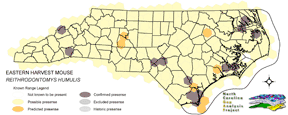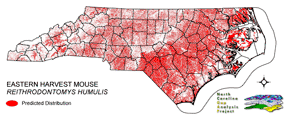
| Taxa: |
| Order: |
| Family: |
| Mammalia |
| Rodentia |
| Muridae |
| NatureServe Global Rank: |
| NatureServe State (NC) Rank: |
| G5 |
| S4 |
| Federal Status: |
| NC State Status: |
| --- |
| --- |


| Land Unit |
| US Fish & Wildlife Service |
| US Forest Service |
| US National Park Service |
| US Department of Defense |
| NC State Parks |
| NC University System |
| NC Wildlife Res. Com. |
| NC Forest Service |
| NC Div. of Coastal Mgmt. |
| Local Governments |
| Non-Governmental Org. |
| Other Public Lands |
| Private Lands |
| GAP Status 1-2 |
| All Protected Lands |
| Statewide |
| Hectares |
| 28,570.68 |
| 20,742.75 |
| 75,577.77 |
| 12,348.90 |
| 4,668.93 |
| 4,456.89 |
| 29,469.60 |
| 4,813.32 |
| 1,533.15 |
| 1,033.29 |
| 5,003.73 |
| 3,343.86 |
| 4,801,003.38 |
| 56,906.49 |
| 188,761.80 |
| 4,992,566.25 |
| Acres |
| 70,599.67 |
| 51,256.44 |
| 186,756.70 |
| 30,514.79 |
| 11,537.18 |
| 11,013.21 |
| 72,820.95 |
| 12,170.78 |
| 3,788.50 |
| 2,553.31 |
| 12,364.48 |
| 8,262.86 |
| 11,863,535.41 |
| 140,895.78 |
| 466,717.28 |
| 12,337,174.28 |
| % of Dist. on |
| Prot. Lands |
| 15.1 % |
| 11.0 % |
| 39.5 % |
| 6.5 % |
| 2.5 % |
| 2.4 % |
| 15.1 % |
| 2.5 % |
| 0.8 % |
| 2.6 % |
| 2.6 % |
| 1.4 % |
| < 0.1 % |
| 30.1 % |
| ----- |
| ----- |
| % of Dist. on |
| All Lands |
| 0.6 % |
| 0.4 % |
| 1.5 % |
| 0.2 % |
| < 0.1 % |
| < 0.1 % |
| 0.6 % |
| < 0.1 % |
| < 0.1 % |
| < 0.1 % |
| 0.1 % |
| < 0.1 % |
| 96.2 % |
| 1.1 % |
| ----- |
| ----- |
|
This mouse of open habitats is an uncommon state-wide resident, but is rare and limited to lower valleys of the mountains (Webster et al. 1985). The eastern harvest mouse utilizes a variety of open grassy or brushy habitats (Whitaker and Hamilton 1998). It can be found in upland fields and meadows, open forest, forest clearings, tangled patches of brier or blackberry, roadside ditches, and in wet bottomlands and grassy flats. Old fields with tall grasses, such as broom sedge, are preferred (Brown 1997). NATURE SERVE GLOBAL HABITAT COMMENTS: Prefers old fields, marshes, and wet meadows. Climbs among herbaceous vegetation. Nests are placed in tangled vegetation under debris or above ground. |
| Code | Name | Description | NC Natural Heritage Program Equivalent |
| 3 | Tidal Marsh | Fresh and brackish tidal marshes, including cord grass, wild rice, sawgrass and needlerush alliances. | Brackish Marsh, Interdune pond, Maritime wet grassland |
| 372 | Interdune Herbaceous Wetlands | Dune swales with permanently flooded to intermittently exposed hydrology. Species composition depends on salinity and can include cut grass, spike-rush, mosquito fern, and hornwort. | Interdune Pond, Maritime Wet Grasslands |
| 371 | Maritime Grasslands | Dune grass community consisting of sea oats and beach grasses. | Dune grass, Maritime dry grassland |
| 380 | Coastal Plain Fresh Water Emergent | Emergent vegetation in fresh water seepage bogs, ponds and riverbeds of the coastal plain. Includes alliances dominated by sedges, eelgrass, as well as cane found in unforested cane-brakes. | Small Depression Pond, Sandhill Seep, Floodplain Pool, Unforested Floodplain Canebrake, Riverscour Prairies, Vernal Pools |
| 97 | Mesic Longleaf Pine | Longleaf pine woodlands without a major scrub oak component. Slash or loblolly pines may be present as well. | Mesic Pine Flatwoods |
| 42 | Xeric Longleaf Pine | Sandhills including a range of longleaf pine density from predominantly wiregrass, scrub oak dominated to true longleaf pine woodland. This does not include mesic or saturated flatwood types. | Xeric Sandhill Scrub, Pine/Scrub Oak Sandhill, Coastal Fringe Sandhill |
| 239 | Piedmont/Mountain Emergent Vegetation | Emergent vegetation of all wetland hydrologies. Sites would commonly support species such as tussock sedge, rushs, and cattail alliances. | Rocky Bar and Shore (in part) |
| 20 | Coniferous Regeneration | Regenerating pine stands. Predominantly loblolly pine, but slash and longleaf stands occur as well. | No equivalent |
| 36 | Successional Deciduous Forests | Regenerating deciduous trees with a shrub stature. Commonly dominated by sweetgum, tulip poplars and maples. | No equivalent |
| 180 | Agricultural Crop Fields | Farm fields used for row crops. | No equivalent |
| 205 | Agricultural Pasture/Hay and Natural Herbaceous | Farm fields used for pasture grass or hay production, as well as old fields dominated by native and exotic grasses. | No equivalent |
| 202 | Residential Urban | Includes vegetation interspersed in residential areas. Includes lawns, mixed species woodlots, and horticultural shrubs. Vegetation accounts for between 20 - 70% of the cover. | No equivalent |
| 203 | Urban Low-Intensity Developed | Highly developed areas with vegetation accounting for < 20% of the cover. | No equivalent |
|
Howell, A. H. 1914. Revision of the American harvest mice (genus Reithrodontomys). North American Fauna 36:1-97. Brown, L. N. 1997. A guide to the mammals of the southeastern United States. University of Tennessee Press, Knoxville. xiv + 236 pp. Whitaker, J.O. Jr. and W.J. Hamilton, Jr. 1998. Mammals of the eastern United States. Cornell Univ. Press, Ithaca, New York. 583 pp. Cawthorn, J. M., and R. K. Rose. 1989. The population ecology of the eastern harvest mouse (Reithrodontomys humulis) [sic] in southeastern Virginia. Am. Midl. Nat. 122:1-10. Lowery, G. H., Jr. 1974. The mammals of Louisiana and its adjacent waters. Louisiana State University Press, Baton Rouge. 565 pp. Davis, W. B. 1978. The mammals of Texas. Texas Parks and Wildlife Dept., Bull. No. 41. 294 pp. Hamilton, William J., Jr., and John O. Whitaker, Jr. 1979. Mammals of the eastern United States. Cornell Univ. Press, Ithaca, New York. 346 pp. Hall, E. R. 1981. The Mammals of North America. Second edition. 2 Volumes. John Wiley and Sons, New York, New York. Webster, W. D., J. F. Parnell and W. C. Biggs Jr. 1985. Mammals of the Carolinas, Virginia, and Maryland. The University of North Carolina Press, Chapel Hill, NC. |
For more information please contact them at:
NC-GAP Analysis Project
Dept. of Zoology, NCSU
Campus Box 7617
Raleigh, NC 27695-7617
(919) 513-2853
www.basic.ncsu.edu/ncgap